open/close all folders
Party members
Aziel / Azielle


- Garden Garment: Azielle's outfit is made from leaves. Since she's a faery, not many are required. (Aziel's outfit, by contrast, is more traditional).
- Magic Wand: Azielle uses one which shoots lightning.
- Mutually Exclusive Party Members: Aziel and Azielle are male and female versions of the same basic character — you meet Aziel (male) if you play a female character and Azielle (female) if you play a male character. They don't seem to both exist in the world at the same time — it's like Schrödinger's Player Character, except not for the player character.
- Rebellious Prince/Princess: They don't have a good relationship with Oberon, their father. When players learn what Oberon's been up to, this turns into outright rebellion, and players can side with Aziel/Azielle against Oberon.
- Shock and Awe: Aziel and Azielle specialise in electricity-based magic.
- Winged Humanoid: Like most faeries, they both have wings, although Aziel's are feathered and Azielle's are butterfly-like.
Bert

- All Trolls Are Different: Trolls, in this world, are faery-sized, ugly, and sometimes quadrupedal. Bert, however, can fly — since he doesn't have wings, this is probably magic.
- Gratuitous Iambic Pentameter: Bert talks in rhyming poetry — except when he's confessing to having been sent to spy on you, which makes him too nervous to keep the rhyming up.
- The Mole: He has been sent by Oberon to watch the player character for signs of rebellion, but regrets it and eventually comes clean.
- My Species Doth Protest Too Much: Trolls are usually stupid and violent, but Bert is an exception — he's bookish and likes to talk in verse. The other trolls bully him, naturally.
- Throw the Book at Them: Bert carries a hefty book around with him, and hits people with it in combat. He even uses it as part of his spells, using it to swat magically-formed projectiles at enemies.
Drake

- Cuteness Proximity: Some of the player character's conversations with Drake involve this.
- Egg MacGuffin: Players discover a dragon egg near the start of the game, and when they get to Yggdrasil, they can hatch it to meet Drake. This requires a bit of work, since the egg needs to be incubated (which is achieved by disguising it as a bird egg and letting a bird do the job).
- Playing with Fire: As befits a baby dragon, Drake can attack with fire. This goes beyond fire-breathing to actual fire magic of the sort that the player character can use.
- Team Pet: As a baby dragon, Drake fits this role — although in terms of gameplay mechanics, there's no difference between him and other party members.
Grim
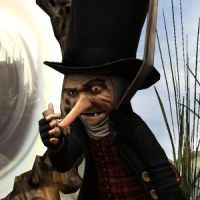
- Better with Non-Human Company: He doesn't have a high opinion of people, and prefers to avoid dealing with them. He is, however, good with animals.
- Hellhound: In times past, he took the form of a large dog and protected sacred places — this is the origin of human legends of "the Grim". However, he is no longer in this form by the time players meet him.
- Jerk with a Heart of Gold: For all that he snaps at people, he doesn't actually wish them ill, and it's possible to win his approval.
- Nature Lover: He likes animals, and when first encountered, is trying to help an animal out of a trap.
Amareta
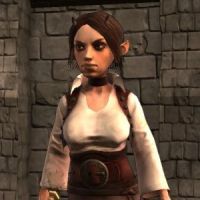
- Brutal Honesty: She considers this a virtue, and approves of it when you criticise her instead of trying to be polite and tactful all the time.
- Our Fairies Are Different: Amareta is a faery, but of a different type to the player character and Aziel/Azielle — she's a korrigan, from Breton folklore. Korrigans are sometimes described as dwarf-like, but if she does count as a dwarf, she's not a stereotypical one.
- Pirate Girl: She's part of the crew of the Flying Dutchman (although unlike many, she's not a ghost).
- Sword and Gun: She wields both in combat.
- Making a Splash: In addition to her regular weapons, she can also use water magic in combat (fittingly for a seafarer). This includes ice magic.
- Vitriolic Best Buds: This is her ideal — she's quite happy to laugh at jokes you make at her expense, and dislikes it if you're always trying to praise and compliment her.
Selim

- Genie in a Bottle: Selim is a djinn, although he isn't in a bottle. (He's found an an "Arabian Nights" Days world inhabited by a variety of creatures from Middle Eastern folklore.)
- Walking the Earth: Or rather, walking the multiple worlds of the faeries.
- Walking Shirtless Scene: As seen in his picture.
Other characters
Oberon

- The Good King: He's generally seen as this by his subjects in Avalon. His subjects on other worlds, however, range from wary to contemptuous, believing that he's only interested in drawing power from their worlds while paying no attention to their problems. In fact, he turns out to be causing some of those problems.
- Horned Humanoid: Other faeries may have small horns, but Oberon has huge antlers. Player characters can develop tiny horns as part of the leveling-up process, so if horn size is indicative of experience and power, Oberon obviously has a lot.
- Shoot the Dangerous Minion: It turns out that this is sort of what he did to you before the start of the game, except he put you stasis rather than kill you outright. He tries to defend himself by pointing out that although he froze you, he's also the one who woke you up again; of course, that was just because he needed your services again.
Dryad
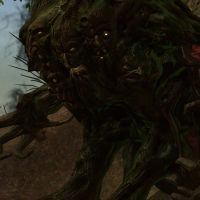
- Driven to Madness: The pollution of Yggdrasil has driven the dryad insane, although she recovers once the area around the tree is cleansed (and once you've beaten her in a fight).
- Multiple Head Case: Perhaps not so much multiple heads as multiple faces, but she's got them. Whether this is normal or a result of corruption isn't stated.
- Nature Spirit: The dryad is closely bound to Yggdrasil, the great tree. She may count as a Plant Person, though she's certainly not the attractive-young-woman type of dryad often found in stories (although some of her current appearance is probably a result of Yggdrasil's corruption).
Ghost sailors

- Attack of the 50-Foot Whatever: Since they're human ghosts, they come across as this to the much smaller faery player character.
- Flying Dutchman: They make up the majority of the crew of the Flying Dutchman (the ship that human legends are based on).
- The Mutiny: When players arrive on the scene, the crew of the ship have mutinied. Their main complaint is that the non-ghost crew (consisting of korrigans) are ill and should be quarantined. (The question of how ghosts would catch a disease isn't of much interest to them.) They've forced the captain to barricade himself in his cabin, but Senta, the banshee figurehead of the ship (and the captain's lover) wants the mutineers purged.
Mermaids
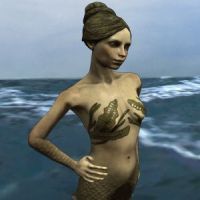
- Giant Woman: They're actually human-sized, but since faeries are much smaller than that, they come across as huge.
- Our Mermaids Are Different: There are a number of mermaids in the game, and they vary in disposition. Manon, who is fond of a fisherman who recites poetry to her, is prepared to help you if he sends you to her. Melusine (who is the basis for the European folktale) is also friendly to you. The other three (sirens who are preventing the Flying Dutchman from leaving) are rather less friendly, and won't cooperate without payment.
- Sirens Are Mermaids: Some of them, at least. Leucosia, Ligeia, and Thelxiepeia all have names which are sometimes ascribed (stories vary) to the sirens of mythology, and are implied to be the inspiration for those stories.
Senta

- Giant Woman: As with the mermaids, she's human-sized, but appears giant to the non-human-sized faeries.
- Living Figurehead: Senta is one ever since her soul became one with the figurehead of the Flying Dutchman.
- The Mutiny: She enacts a sort of mutiny against the mutineers, whom she doesn't want to join - because the captain against whom they're waging the mutiny is her lover.
- Together in Death: Senta is the inspiration for the character of that name in Richard Wagner's The Flying Dutchman, in that she killed herself by she diving into the sea so as to be with her ghostly fiancé forever. Unlike in the opera, however, this did not mark the redemption of the Flying Dutchman and the ascent of both of them to heaven. Rather, Senta has simply become part of the ship, being referred to as its figurehead.
Shipwrecker
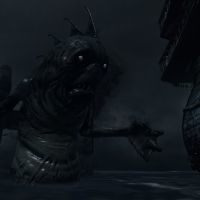
- Sea Monster: The Shipwrecker is a huge creature (of hard-to-determine overall shape) which follows along in the wake of the Flying Dutchman and consumes ships.
- Too Spicy for Yog-Sothoth: Something that the Shipwrecker ate has made it ill, which bodes poorly for everyone around it. It's your job to figure out what to do. This turns out to be giving the Shipwrecker a potion which will cause it to throw up whatever it ate — but since the Shipwrecker isn't going to cooperate with that, you'll have to beat it up first.
Peri priestesses
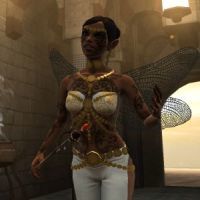
- "Arabian Nights" Days: Peris are found in Middle Eastern folklore, and the peri priestesses of the City of Mirages look a bit like they're inspired by belly dancers.
- The Heretic: They consider the sphinx who opposes them to be this, since he believes he can talk with the giant scarab beetle on which the City of Mirages is built. The priestesses believe that it is divine, and that prayer is the only possible way to communicate with it.
- Reasonable Authority Figure: Not at first — they insist that they're the only ones able to communicate with (what they consider to be) their god. Once they're shown to be wrong, however, they quickly revise their position, and their concern for the city is genuine.
Ifrit

- Well-Intentioned Extremist: He's fighting for a reasonably good cause (his city's freedom), and he used to do so in a moderate way — it's mentioned that he used to give speeches about it. Lately, however, he has dropped out of view, and it turns out that he's the one behind the problems the city is now experiencing.
- Missing Steps Plan: He doesn't make it very clear just how exactly his actions are supposed to bring about the liberation of the City of Mirages. In fact, they may destroy it.
- Your Terrorists Are Our Freedom Fighters: The ifrit's actions are endangering the City of Mirages, but he sees himself as fighting the tyranny of Oberon.
